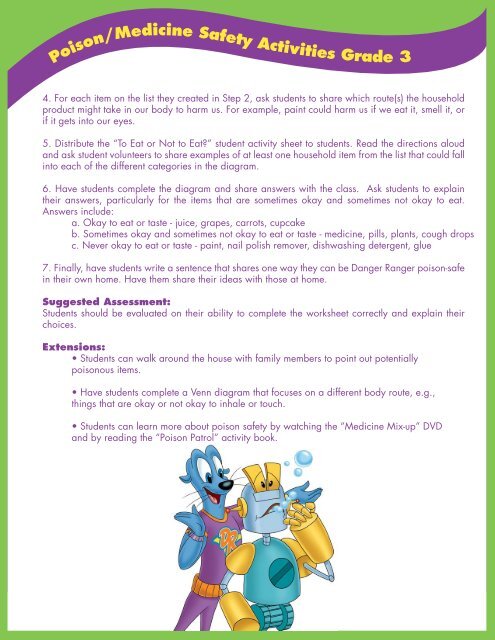Curriculum Grade 3
Curriculum Grade 3 Curriculum Grade 3
Poison/Medicine Safety Activities Grade 3 4. For each item on the list they created in Step 2, ask students to share which route(s) the household product might take in our body to harm us. For example, paint could harm us if we eat it, smell it, or if it gets into our eyes. 5. Distribute the “To Eat or Not to Eat?” student activity sheet to students. Read the directions aloud and ask student volunteers to share examples of at least one household item from the list that could fall into each of the different categories in the diagram. 6. Have students complete the diagram and share answers with the class. Ask students to explain their answers, particularly for the items that are sometimes okay and sometimes not okay to eat. Answers include: a. Okay to eat or taste - juice, grapes, carrots, cupcake b. Sometimes okay and sometimes not okay to eat or taste - medicine, pills, plants, cough drops c. Never okay to eat or taste - paint, nail polish remover, dishwashing detergent, glue 7. Finally, have students write a sentence that shares one way they can be Danger Ranger poison-safe in their own home. Have them share their ideas with those at home. Suggested Assessment: Students should be evaluated on their ability to complete the worksheet correctly and explain their choices. Extensions: Students can walk around the house with family members to point out potentially poisonous items. Have students complete a Venn diagram that focuses on a different body route, e.g., things that are okay or not okay to inhale or touch. Students can learn more about poison safety by watching the “Medicine Mix-up” DVD and by reading the “Poison Patrol” activity book.
Poison/Medicine Safety Activities Grade 3 “To Eat or Not to Eat?” student activity sheet Directions: Using the Venn diagram below, sort the household products from the box into three categories: those that are always okay to eat, those that are sometimes okay and sometimes not okay to eat, and those that are never okay to eat. Things in my house that are okay to eat Things in my house that are sometimes okay and sometimes not okay to eat Household Products: cough drops grapes glue medicine dishwashing detergent juice paint cupcake carrots nail polish remover pills plant Things in my house that are never okay to eat
- Page 2 and 3: Poison Curriculum Dear Educator: Ed
- Page 4 and 5: Make your lesson plans complete wit
- Page 6 and 7: An Introduction to Poison and Medic
- Page 10 and 11: Poison/Medicine Safety Activities G
- Page 12 and 13: Poison/Medicine Safety Activities G
- Page 14 and 15: Poison/Medicine Safety Activities G
- Page 16: Poison/Medicine Safety Vocabulary G
- Page 19: Student’s Name is Poison Prepared
Poison/Medicine Safety Activities <strong>Grade</strong> 3<br />
4. For each item on the list they created in Step 2, ask students to share which route(s) the household<br />
product might take in our body to harm us. For example, paint could harm us if we eat it, smell it, or<br />
if it gets into our eyes.<br />
5. Distribute the “To Eat or Not to Eat?” student activity sheet to students. Read the directions aloud<br />
and ask student volunteers to share examples of at least one household item from the list that could fall<br />
into each of the different categories in the diagram.<br />
6. Have students complete the diagram and share answers with the class. Ask students to explain<br />
their answers, particularly for the items that are sometimes okay and sometimes not okay to eat.<br />
Answers include:<br />
a. Okay to eat or taste - juice, grapes, carrots, cupcake<br />
b. Sometimes okay and sometimes not okay to eat or taste - medicine, pills, plants, cough drops<br />
c. Never okay to eat or taste - paint, nail polish remover, dishwashing detergent, glue<br />
7. Finally, have students write a sentence that shares one way they can be Danger Ranger poison-safe<br />
in their own home. Have them share their ideas with those at home.<br />
Suggested Assessment:<br />
Students should be evaluated on their ability to complete the worksheet correctly and explain their<br />
choices.<br />
Extensions:<br />
Students can walk around the house with family members to point out potentially<br />
poisonous items.<br />
Have students complete a Venn diagram that focuses on a different body route, e.g.,<br />
things that are okay or not okay to inhale or touch.<br />
Students can learn more about poison safety by watching the “Medicine Mix-up” DVD<br />
and by reading the “Poison Patrol” activity book.



